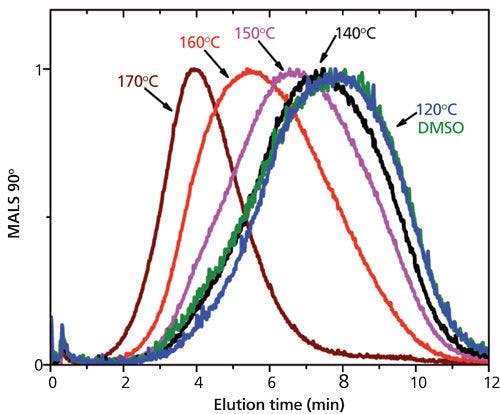Practical Applications of Asymmetrical Flow Field-Flow Fractionation: A Review
LCGC North America
This review highlights applications for which AF4 is particularly well suited, and explains when not to use the technique.
Characterization of macromolecules and colloids is an area of considerable interest. Asymmetrical flow field-flow fractionation (AF4) has become a well-established method, but many potential users possess limited knowledge of its capabilities, or how it can provide additional information or serve as validation to the traditional analytical techniques. This review article highlights several practical applications where AF4 should be given special consideration, and discusses benefits and drawbacks of the different methods.
It is almost 50 years since the late Professor Giddings (1) invented field-flow fractionation (FFF)-a family of separation techniques. A number of different subtechniques exist including centrifugal FFF (CFFF), thermal FFF (TFFF), and electrical FFF (EFFF), each with its own appropriate application area. However, the most widely spread and commonly used subtechnique is asymmetrical flow field-flow fractionation (AF4) (see Table I). From the first reports of AF4 in the 1980s (2) the technique has evolved to become a well-established method for size separation of macromolecules and particles in academia. The technique has also found its way into the industry, largely because of the availability of commercial systems in the latter half of the 1990s.
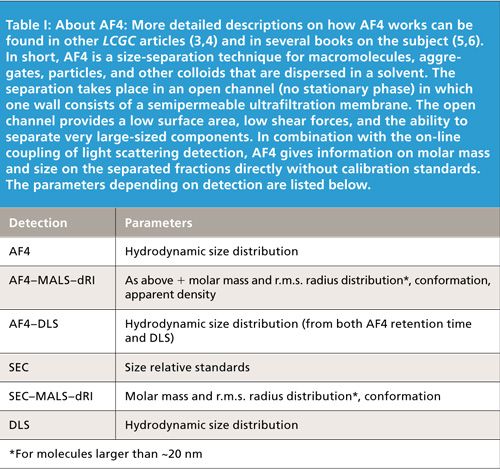
However, many potential users have still not heard about AF4 or refrain from using it because they have little experience with the technique. With the advent of improved instrumentation and an ever-increasing number of articles to help to select separation parameters, the relevance of AF4 is being re-evaluated. In this review article we highlight applications where AF4 is especially well suited in comparison to other common techniques.
Detection of Protein Aggregates
Studies of protein aggregation are common in both academia and industry. Protein aggregation can be of fundamental interest to understand the characteristics of a protein, but is also important to assess during product development and optimization, or to study the stability of the finished formulation. Size-exclusion chromatography (SEC) is a well-proven and excellent method for size separation of macromolecules, and is often used for size characterization of proteins including aggregation studies. However, it has been reported that SEC has limitations for the protein aggregates, indicating that the method is not always well suited for the separation and detection of higher aggregates (7–9), which can result in low recovery (10).
An example of differences that can be noticed in the results from SEC and AF4 analyses of an aggregated protein is presented in Figure 1. The sample is a solution of IgG (molecular weight ~150 kDa) that is well-known to aggregate at elevated temperatures. For this illustration the solution was heated to ~65 °C for 5 min to promote the formation of aggregates. Elution of the protein monomer and dimer from AF4 was detected on both the differential refractive index (dRI) and multiangle light-scattering (MALS) detectors. The light-scattering detector, which is very sensitive to high molar mass compounds, also picked up the elution of much higher aggregates (not detected in the IgG solution before heat-stress). The amount of these aggregates is low compared to the monomer and dimer, representing less than 10% of the total protein. In contrast to the AF4 results, no higher aggregates were detected in the analysis by SEC. This is presumably a result of either shear degradation of the higher aggregates or that the aggregates are not eluted from the column.
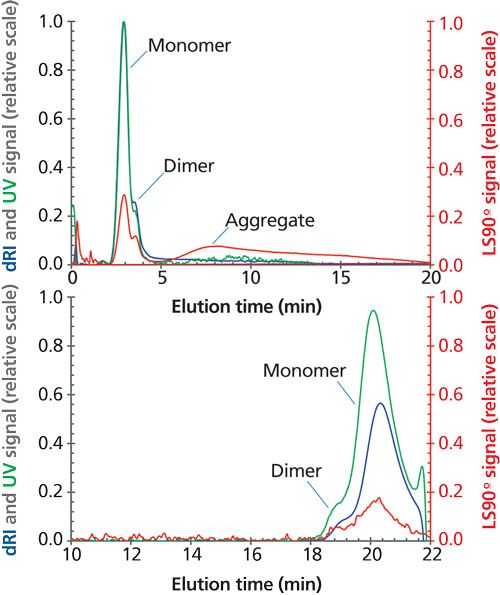
Figure 1: Separation of heat stressed IgG by (a) AF4–UV–MALS–dRI and (b) SEC–UV–MALS–dRI.
The SEC column had a nominal pore size of 1000 Å, a nominal protein molecular weight separation range of 50–7500 kDa, and was operated at the relatively low flow rate of 0.5 mL/min (7.8 mm i.d. column). Hence, the protein and potential aggregates are expected to be well within column specifications. Nevertheless, the higher protein aggregates were not eluted from the column. Optimization of elution conditions such as the mobile-phase ionic strength and other additives (10 mM sodium nitrate in water was used) and testing of a variety of columns with different pore-sizes and chemistries could improve the situation. However, it is not certain that one would go through such an optimization procedure unless there is an indication that the current SEC method may fail to detect the aggregates. Great care should therefore be taken when estimating protein aggregation based on data from one method alone; the use of a complementary technique can be valuable for validation reasons.
Size Distribution of Nanoparticles
Nanoparticles are becoming more and more closely studied. One property of high interest is the particle size, which is commonly analyzed with dynamic light scattering (DLS). This technique measures the fluctuations in scattered light from a sample (such as a particle dispersion) over time and provides information on the hydrodynamic diameter. DLS has several benefits such as compatibility with most solvents and is a relatively fast technique with low workload for the user. However, in some cases, it is difficult to obtain reliable size distribution data (11) on complex samples such as particles with multimodal (12) or broad size distributions (13), or when measuring small particles at low concentrations. This can be explained by the fact that an inherent property of DLS is that the measurements are performed on unfractionated samples, making the data processing and evaluation more complicated for samples with broad size distributions. For small particles, the limitation lies in the relatively low scattering intensity (the intensity of scattered light increases with particle size by the power of 6), which becomes especially challenging if the concentration is low.
The following example is from a recent project in which we participated where DLS was used to characterize the size of nanoparticles. Our DLS measurement gave an average hydrodynamic size of 73 nm and a polydispersity index of 0.25, which was in excellent agreement with the data given by the supplier; 72 nm and 0.25, respectively (also determined by DLS). Looking at the intensity graph from the DLS (Figure 2) it is obvious that the size distribution is broad (ranging from 10 to 400 nm) but there was otherwise no indication of anything remarkable. Possibly there is an indication of a shoulder on the size distribution curve at approximately 20–30 nm.
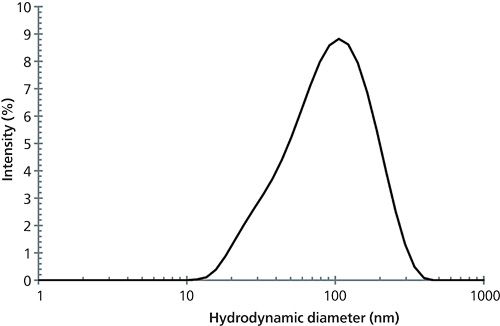
Figure 2: Size distribution of nanoparticles using DLS.
In contrast, AF4 analysis of the same sample gave a more detailed picture of the size distribution (Figure 3). The use of MALS-dRI detection gave molar mass and r.m.s. radius (a measure of [molecules or particles] size weighted by the mass distribution around its center of mass) information directly of the eluted fractions (independent of the separation and no standards necessary). The analysis detected three size populations on the refractive index and light scattering detectors. The first population (I) eluted from 2–5 min, the second (II) from 5–10 min, and the last (III) was visible mainly in the MALS-signal from 11–18 min. The size populations were incompletely resolved, partly as a result of band broadening, but a major factor is likely overlapping size distributions. This particle was produced in a two-step process, with a solid core that was coated. The core had a size of 5–10 nm as determined with transmission electron microscopy (TEM) prior to coating (likely population I in Figure 3). The second size population (II) probably corresponds to successfully coated particles and the third size population (III) to aggregated particles.

Figure 3: Size characterization of nanoparticles using (a) AF4 and (b) particle hydrodynamic diameter distribution obtained from the AF4 elution times, for comparison with Figure 2. (a) The blue trace is the dRI and red trace is the MALS 90° fractograms. Right axis is the root-mean-square (r.m.s.) radius of the eluted fractions (green circles) determined directly by MALS. Different size populations are indicated by I, II, and III. The early dRI peak (marked with 0) shows the elution of salts in the sample solution.
DLS is a rapid tool, excellent for fast screenings of well defined, low dispersity samples. However, this data illustrates the difficulties involved in detecting different size populations in a complex sample using DLS and is one example when it could be suitable to characterize the sample with AF4. The use of a separation technique also offers the potential for an additional dimension because the size fractions can be collected and analyzed by other techniques to further characterize the sample.
Molar Mass and Size Determination of Large Polysaccharides
Polysaccharides are a class of compounds that are used in a wide variety of applications. Some of the polysaccharides, such as starch and cellulose, can be very large and are often used for rheological modification of products. However, the large sizes can also result in challenging size distribution analysis (14,15). Often only average properties are reported, or indirect measurements of the size such as viscosity. However, with AF4 it is possible to analyze very large polysaccharides (16–19) as well as supramolecular aggregates (20–22). Size analysis can be important because the molar mass distribution can be affected during functionalization or by processing conditions (23–28).
The analysis of amylopectin (one of the main constituents of starch) by AF4 is presented in Figure 4. Amylopectin is a branched polysaccharide of very large size and molar mass. Molar mass ranges from approximately ten million up to several hundred millions g/mol and r.m.s. radius ranges up to ~250 nm corresponding to a hydrodynamic diameter of 400–500 nm, which emphasizes the large size range over which AF4 can operate.
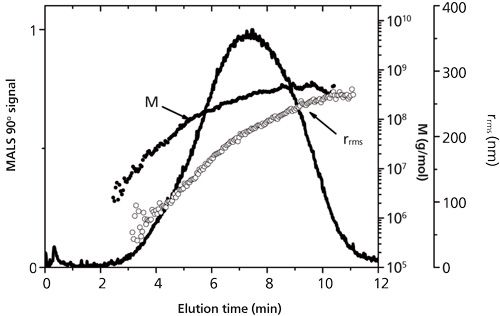
Figure 4: AF4–MALS fractogram showing molar mass (M, obtained from MALS–RI) and r.m.s. radius versus elution time for maize amylopectin obtained from dissolution in water at 140 °C (autoclave). Adapted and reproduced with permission from reference 28, ©Springer.

In this case AF4 was used to monitor dissolution conditions. Amylopectin is not easily dissolved in water, and the dissolution conditions can have a pronounced effect on the properties of the final amylopectin solution. In this example the dissolution temperature and its impact on the size distribution was investigated and compared to dissolution in dimethyl sulfoxide (DMSO) (Figure 5). The AF4 analysis clearly revealed the impact of high temperature dissolution conditions on the amylopectin (degradation) and provided guidance on how to choose the amylopectin processing conditions for the particular application.

Figure 5: The effect of dissolution conditions (120–170 °C in water in an autoclave and in DMSO at 100 °C) on the elution time in AF4–MALS of maize amylopectin. AF4 analyses were performed under aqueous conditions. Adapted and reproduced with permission from reference 28, ©Springer.
Using SEC for such large compounds as in the example above would definitely be challenging. The size of the amylopectin would likely be excluded from the pores of the stationary phase. Furthermore, even if the pores are sufficiently large enough to allow the amylopectin to enter, the flow rate has to be kept very low to allow the sample time to diffuse in and out of the pores. In addition, shear degradation of amylopectin readily occurs as has been shown by Cave and colleagues (29).
Size Analysis of Vesicles/Liposomes
Liposomes as carriers for pharmaceutically active compounds have attracted both academic and commercial interest for several decades. One parameter that really matters in drug applications of liposomes is the size distribution because it has a considerable impact on the clearance of the liposomes from the blood stream (30–32).
AF4 is a technique very well suited for liposome characterization (33–38). The open channel reduces the risk of shear-induced changes to the sample and has a very low surface area (typically in the order of 10-3–10-2 m2) compared to packed columns (at least 1–10 m2/g stationary phase). An example of an AF4 analysis of liposomes is presented in Figure 6. The liposome size distribution was investigated after different processing steps for different liposome preparation procedures.
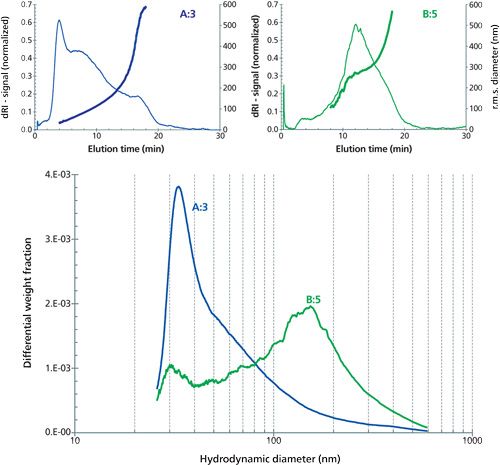
Figure 6: AF4 analysis of liposomes prepared by procedure A (top left graph) and B (top right graph), respectively, taken at different points in the respective procedure. Also plotted is the hydrodynamic diameter distribution of the liposomes (lower graph, log scale, obtained from the AF4 elution times).
The AF4 separation demonstrated good recovery (98%) and was able to separate the relatively disperse systems, with liposome distributions spanning from ~25 to ~500 nm depending on production protocol. The use of a separation method also allowed different liposome size fractions to be collected after the AF4, and analyzed for their compositions by, for example, liquid chromatography-mass spectrometry (LC–MS).
The most commonly used techniques to analyze size and size distribution of liposomes are DLS and SEC (39). DLS suffers from the same limitations as was mentioned in the nanoparticle example above (difficulty to obtain accurate size distribution data for broad or complex size distribution), and this has also been noted for liposomes (35). SEC differs from DLS in that it gives a physical separation of the differently sized liposomes, enabling direct measurement of the size distribution (40–43). However, lipid adsorption to the SEC column is often reported (41,43). To counter this, it is sometimes recommended to saturate (41) the column by several injections of lipid before the actual separation can be performed. Obviously, saturating the stationary phase before separation might affect column performance and retention properties. Therefore, using AF4 in such cases might be a better option.
Separation of Branched Polymers
Branched polymers are a widely used class of macromolecules. The amount of branching as well as the molar mass is of considerable interest since it can have a profound affect on the properties of the polymer in the application. Both parameters can be investigated by SEC when connected to viscosity and light-scattering detectors. However, it is not uncommon to see reports with anomalies in the elution behavior when analyzing branched polymers (44–51), making the evaluation challenging or even impossible. Several investigations point at the difficulties of separating branched high molar mass polymers. One suggested explanation has been anchoring of the branches in the SEC stationary phase pores (47).
For polymers of this complex character, AF4 is an attractive alternative. One illustrative example of using AF4 for separation of branched polymers can be seen in Figure 7 (including a comparison with SEC). The absence of a packing material in AF4 significantly reduces the risk for shear-induced degradation or branches interacting with a stationary phase.
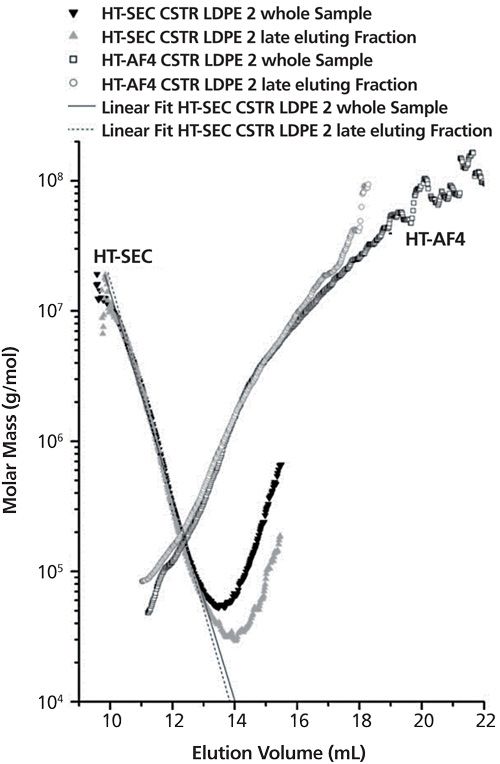
Figure 7: Analysis of polyethylene by AF4 and SEC showing molar mass as a function of elution volume. Note the inversion of the elution order from SEC at 14–16 mL elution volume range. Adapted and reproduced with permission from reference 49, ©Elsevier.
When Not to Use AFFF-And What Not to Expect
Compounds smaller in size than the cut-off of the membrane used are not possible to analyze. The most commonly used membranes have a nominal molecular weight cut-off of 5 kDa, or 10 kDa, which gives an indication of the practical lower limit of AF4. SEC can be expected to exhibit better efficiency or fractionating power than FFF for low-molecular-weight compounds (~ 104 g/mol range and less) (52–54).
If the amount of sample is very limited, the use of AF4 might not be possible. The amount injected (in terms of mass) is comparable to what is used in SEC, usually 10–100 µg depending on detection. However, one benefit of AF4 is that if the sample concentration is low, larger volumes can be analyzed (thus reaching the required detection) without affecting resolution thanks to the initial focusing step when the analytes are relaxed in the channel.
The length of an AF4 separation varies depending on sample complexity. In general, total AF4 analysis time (injection, focusing, and elution) is in the 15–60 min range. Add to this the time for data evaluation, which can be very fast for a simple yes or no answer or take considerably more time if data from multiple detectors are to be evaluated and sample characteristics in terms of conformation, branching, and density are desired. Therefore, answers are not obtained as fast as with DLS; however, AF4 offers considerably shorter run times compared to analytical ultracentrifugation.
While AF4 does separate according to size, which in turn is related to mass, do not expect mass spectrometry-like data with isotope resolution. The resolution is simply not of that magnitude.
Conclusion
We have offered some examples where AF4 should be considered in comparison to other commonly used techniques, either because it can provide additional or complementary information or can serve as validation of other analytical techniques. Speaking in general terms, AF4 should be considered when the analytical task involves:
- aggregation-prone samples or when investigating aggregation and aggregate properties;
- broad or complex size distributions;
- large macromolecules;
- shear sensitive samples;
- compounds that are difficult to analyze because of interactions with stationary phases.
References
- J.C. Giddings, Separation Sci. 1, 123–125 (1966).
- K.-G. Wahlund and J.C. Giddings, Anal. Chem. 59, 1332–1339 (1987).
- S. Podzimek et al., LCGC North Am. 27(1), 62–69 (2009).
- R.N. Qureshi and W.Th. Kok, LCGC Europe23(1), 18–25 (2010).
- K.-G. Wahlund, Asymmetrical Flow Field-Flow Fractionation in Field-Flow Fractionation Handbook, M.E. Schimpf, K.D. Caldwell, and J.C. Giddings, Eds. (Wiley, 2000).
- K.-G. Wahlund and L. Nilsson, Flow FFF - Basics and Key Applications in Field Flow Fractionation in Biopolymer Analysis, K. Williams and C. Caldwell, Eds. (Springer, 2012).
- J.S. Philo, Curr. Pharma. Biotech. 10, 359–372 (2009).
- J.P. Gabrielson et al., J. Pharm. Sci.96, 268–279 (2007).
- S. Cao et al., Curr. Pharm. Biotechnol. 10(4), 382–390 (2009).
- A. Hawe et al., Eur. J. Pharm. Sci.38, 79–87 (2009).
- Kato et al., Nanomaterials2, 15–30 (2012).
- C. Franzen et al., AAPS Pharm. Sci. Tech. 4, 62–70 (2003).
- M. Baalousha and J.R. Lead, Environ. Sci. Tech. 46, 6134–6142 (2012).
- W. Yokoyama et al., Cereal. Chem.75(4), 530–535 (1998).
- R.A. Cave et al., Biomacromolecules10(8), 2245–2253 (2009).
- L. Nilsson, Food Hydrocolloids30, 1–11 (2013).
- L. Nilsson, Starch and Other polysaccharides in Field Flow Fractionation in Biopolymer Analysis, K. Williams and C. Caldwell, Eds. (Springer, 2011)
- P. Roger et al., J. Chrom. A917, 179–185 (2001).
- K.G. Wahlund et al., Anal. Bioanal. Chem. 399(4), 1455–1465 (2011).
- A. Håkansson et al., Carb. Polymer87, 518–523 (2012).
- M. Andersson et al., Anal. Chem. 73(20), 4852–61 (2001).
- M. Andersson et al., Biomacromolecules5(1), 97–105 (2004).
- J. R. Runyon et al., Anal. Bioanal. Chem. 406, 1597–1605 (2014).
- S. Lee et al., J. Chrom. A1011, 111–123 (2003).
- G. Modig et al., Food Hydrocoll. 20, 1087–1095 (2006).
- L. Nilsson et al., Biomacromolecules7(9), 2671–2679 (2006).
- M. Ulmius et al., Food Hydrocolloids26(1), 175–180 (2012).
- D. Perez-Rea et al., Anal. Bioanal. Chem.407(15), 4315–26 (2015).
- Cave et al., Biomacromolecules10(8), 2245–53 (2009).
- R.L. Juliano and D. Stamp, Biochem. Biophys. Res. Commun. 63, 651–658 (1975).
- R.M. Abra and C.A. Hunt, Biochim. Biophys. Acta666, 493–503 (1981).
- Liu et al., Biochim. Biophys. Acta1104(1), 95–101 (1992).
- M.H. Moon and J.C. Giddings, J. Pharm. Biomed. Anal.11, 911 (1993).
- Moon et al., J. Chromatogr. A813, 91–100 (1998).
- Hupfeld et al., J. Nanosci. Nanotech. 6, 1–7 (2006).
- G. Yohannes, Dissertation thesis, University of Helsinki, Finland (2007).
- J. Kuntsche, C. Decker, and A. Fahr, J. Sep. Sci.35(15), 1993–2001 (2012).
- Wyatt Technology Corporation, LCGC The Application Notebook, (2011).
- Laouini et al., J. Coll. Sci. Biotech. 1, 147–168 (2012).
- S. Lesieur, C. Grabielle-Madelmont, M.T. Paternostre, and M. Ollivon, Chem. Phys. Lipids64, 57–82 (1993).
- Lundahl et al., J. Chrom. B720, 103–120 (1999).
- Grabielle-Madelmont et al., J. Biochem. Biophys. Methods56(1–3), 189–217 (2003).
- Ruysschaert et al., BMC Biotech. doi:10.1186/1472-6750-5-11 (2005).
- C. Johann and P. Kilz, J. Appl. Polym. Sci. Appl. Polym. Symp. 48, 111–122 (1991).
- D.J. Frater et al., J. Polym. Sci. B35(1), 141–151 (1997).
- M. Gerle Fischer et al., Macromolecules32, 2629–2637 (1999).
- S. Podzimek et al., J. Appl. Polym. Sci. 81(7), 1588–1594 (2001).
- E. Mes et al., J. Chromatogr. A1154(1–2), 319–330 (2007).
- T. Otte et al., J. Chromatogr. A1218(27), 4240–4248 (2011).
- T. Otte et al., J. Chromatogr. A1218(27), 4257–67 (2011).
- A. Makan et al., Macromolecules45(12), 5247–5259 (2012).
- J.J. Kirkland et al., Anal. Chem.52, 1944–54 (1980).
- M.E. Schimpf, Resolution and Fractionating Power in Field-Flow Fractionation Handbook, M.E. Schimpf, K.D. Caldwell, and J.C. Giddings, Eds. (Wiley, 2000)
- K.D. Caldwell, Polymer Analysis by Field-Flow Fractionation in Modern Methods of Polymer Characterization, H.G. Barth and J.W. Mays, Eds. (Wiley, 1991).
Mats Leeman is senior scientist at SOLVE Research and Consultancy AB. Mats holds a PhD in Technical Analytical Chemistry from Lund University where he studied under the supervision of Professor K.-G. Wahlund. He has been using AF4 for more than 15 years for various applications within the pharmaceutical, specialty chemicals, and biotech industries.
Matilda Ulmius Storm is the CEO of SOLVE Research and Consultancy AB. SOLVE is a contract analysis company focusing on material characterization using AF4 among other techniques. The company is based in Lund, Sweden. Matilda holds a PhD in Biomedical Nutrition/Pure and Applied Biochemistry from Lund University where she studied soluble dietary fibers including AF4 to understand the properties and behavior of beta-glucans. She has experience in using AF4 technology for various applications including polysaccharides, proteins, and nanoparticles.
Lars Nilsson is currently Associate Professor in Food Technology at Lund University. He earned his PhD at Lund University in 2007 working on the adsorption of macromolecules during emulsification. After a brief time in the biotech industry, working on formulation and stability of foams, he returned full-time to Lund University in 2009. In 2010 Lars was awarded the AkzoNobel Nordic Prize in Surface and Colloid Chemistry for his work on macromolecular emulsifiers. Current research interests are field-flow fractionation techniques for macromolecules and colloidal dispersions, and structure/functionality relationships in macromolecules and their aggregates, emulsions, and foams as well as brewing technology.
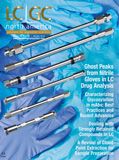
Retaining Talent in Field-Flow Fractionation: An Initiative
The authors present their motivation for establishing the Young Scientists of FFF (YSFFF) initiative within the FFF community.
Developments in Field‑Flow Fractionation Coupled to Light Scattering
December 8th 2020Field-flow fractionation (FFF) coupled to light scattering is a powerful method to separate and characterize nanoparticles, proteins, and polymers from a few nanometres to a few micrometres. The technique is one of the few that can cover the full size range of nanomaterials and provide high-resolution size distributions and additional characterization. New developments in FFF enhance performance and productivity.
Field-Flow Fractionation: Virtual Optimization for Versatile Separation Methods
August 8th 2017Flow-field flow fractionation (flow-FFF) offers highly versatile separations for the analysis of complex fluids, covering a size range of macromolecules and particles from 1 nm to 10,000 nm. However, flow-FFF is often perceived as a difficult technique to learn because of the multiple parameters available for adjustment. Recent advances in software for simulating flow-FFF overcome this obstacle, enabling the virtual optimization of flow-FFF methods and opening up the power of flow-FFF separations to non-experts. An added benefit is the ability to easily analyze particle size distributions by elution time from first principles.






